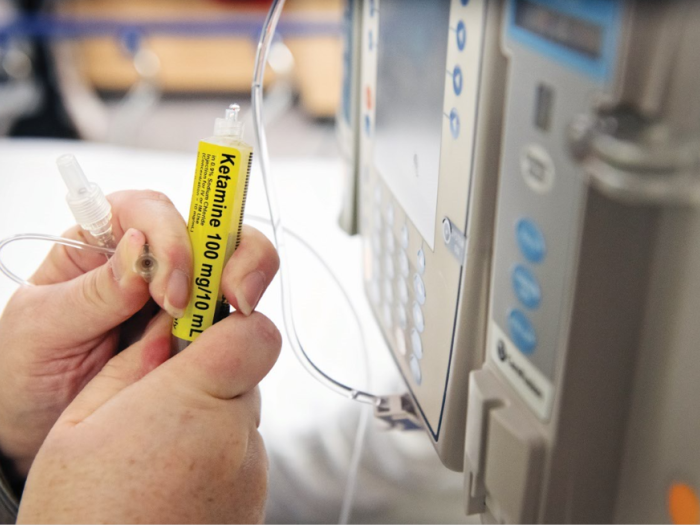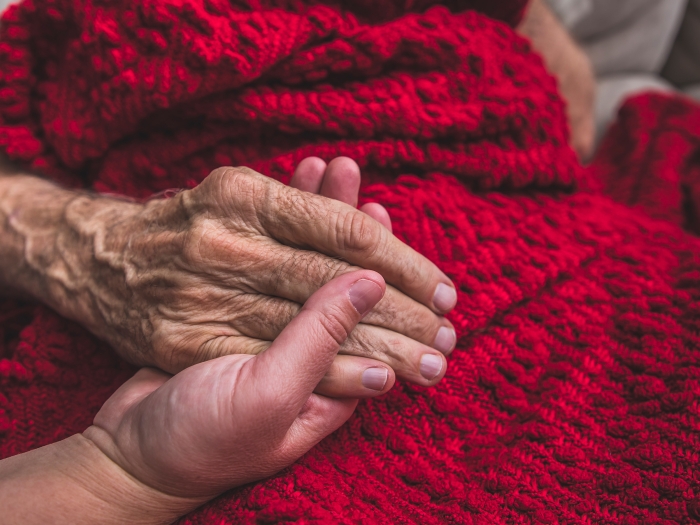New findings show strong response in many patients, but ongoing research aims to find blood biomarkers that might predict success, and compare IV and nasal delivery
5:00 AM
Author |

Using an old anesthesia drug to pull people out of the depths of severe depression has gone from fringe idea to widespread use in just a few years.
Sparked by promising studies and stories of lives transformed, clinics offering intravenous infusions of ketamine have popped up nationwide. Some also offer a newer, more expensive, nasal spray version.
But major questions remain about who ketamine can help, why some people get tremendous relief within days or weeks while others don’t, and the costs and benefits of different ways of delivering the drug.
New findings just came out from a study that seeks to answer some of those questions. They add more evidence about the power of IV ketamine to help some of the most severely ill people with depression or bipolar disorder who haven’t gotten relief from other treatments – including many who have frequent suicidal thoughts.
Called Bio-K, the study involved 74 people treated at four clinics in Michigan, Maryland and Minnesota. After just three infusions of ketamine over 11 days, 52% of participants saw their severe depression ease so much they achieved remission. Another 15% responded somewhat.
Half of those who had thought often of suicide before receiving ketamine experienced a dramatic drop in those impulses. The results are published in the Journal of Affective Disorders.
“These participants are very representative of the sickest patients we see, with more than 80% reporting suicidality that would have excluded them from other depression treatment studies,” said University of Michigan Health psychiatrist and study leader Sagar Parikh, M.D.
“As in other studies of ketamine, the initial response to treatment was a strong predictor of who would do well,” he added. “Two-thirds of those who responded after one infusion went on to achieve remission, while those who hadn’t responded measurably after two infusions were unlikely to start to respond after an additional one.”
Who responds and why?
Indeed, a third of all Bio-K participants didn’t respond to ketamine by the end of the three infusions provided under the study, leaving them to cope with one more failure in a series of attempted treatments.
The team’s in-depth interviews with some of these non-responders show how difficult that can be, as the team reported in a paper last year.
What’s the difference between them and those who responded? That’s a key focus of Bio-K, which is funded by donors to the U-M Eisenberg Family Depression Center.
By studying molecules in blood samples from the study’s participants, the Bio-K team hopes to find biomarkers that could predict who is most likely to get relief from ketamine, and who should try other options.
The study is evaluating cell signaling proteins, inflammatory markers and molecules that can indicate rates of cell metabolism in mitochondria. Early results from those analyses should be available in the next year.
From research to clinical use
In the meantime, the strength of the response in Bio-K participants helped fuel the founding of an IV ketamine clinic at University of Michigan Health, says Parikh, who oversees the clinic.
U-M now accepts referrals from providers across the region who have patients with treatment-resistant depression and need another option after trying at least four medications.
Patients come to the main U-M medical campus around eight times during the span of a month for infusions under the care of psychiatrists, anesthesiologists and other clinicians.
Parikh and his colleagues even wrote a guide for other hospitals on how best to set up and run such a clinic.
Who pays the cost?
Clinics like U-M’s work with health insurers that are willing to pay for some of the cost of ketamine therapy. But many patients pay some or all costs directly, or turn to Michigan Medicine’s financial support program, because insurance coverage varies widely including no coverage for people with Medicare or Medicaid.
That variation is partly because the intravenous form of ketamine doesn’t have an FDA approval specifically for treating depression, and no drug company can profit from seeking such an approval because the drug’s patent lapsed long ago.
In fact, Parikh and colleagues from around the country co-authored a recently published statement in the Journal of Affective Disorders on behalf of the National Network of Depression Centers, calling for more uniform insurance coverage of IV ketamine.
They note that half of all IV ketamine treatments at the network’s 24 centers are at least partly covered by insurance.
In addition to hospital based clinics, Parikh said there’s been a rise in commercial clinics where patients pay thousands of dollars of their own money for ketamine infusions and don’t even seek insurance coverage.
But that’s out of reach for many. And suppliers that are used to working with hospitals that use ketamine routinely for surgical sedation are growing warier of working with such independent clinics.
Parikh notes that his colleagues at the VA Ann Arbor Healthcare System offer IV ketamine treatment to veterans with coverage from the Veterans Health Administration. They recently published data showing encouraging responses in veterans nationwide and hope that more VA hospitals will start to offer it.
A newer version
Meanwhile, the nasal spray form of ketamine, called esketamine and sold under the name Spravato, has captured attention in recent years for its potential to ease disabling and life threatening symptoms without requiring an IV.
The spray involves a form of the drug manufactured by a pharmaceutical company in a way that isolates just one variety of the ketamine molecule, which allowed the company to seek a specific FDA approval.
Parikh notes that U-M was one of the sites for the original small study that led to Spravato’s approval by the FDA, and another larger study sponsored by Janssen, the drug’s manufacturer, that recently concluded. In addition to serving as the local principal investigator for these studies, Parikh also briefly served as a consultant to the company.
Based on the experience in these studies, U-M hopes to start offering Spravato alongside IV ketamine on a clinical basis. Even though it’s not given through an intravenous drip, the nasal spray still requires careful observation of patients under the FDA’s approval conditions.
SEE ALSO: Ketamine helped many severely depressed veterans, study shows
IV vs nasal spray
Even as researchers search for biomarkers to predict ketamine response, clinicians find themselves with a conundrum: Which patients should start with IV ketamine, and which with Spravato? And how do the two compare head to head in actual response to treatment?
That’s what researchers at Yale University, U-M and their colleagues will soon try to find out, through a new study just funded by the federal Patient-Centered Outcomes Research Institute.
The study, which will begin enrolling up to 400 people at six sites nationwide later this year, will randomly assign people with treatment resistant depression to either the IV or nasal spray form of the drug. They’ll then receive that treatment for about four weeks, and have their symptoms monitored during treatment and for months afterward.
Such a head-to-head study might help inform insurers that haven’t yet started covering one or both forms of ketamine, Parikh noted.
More about the Bio-K results
In the meantime, the treatment response results from the Bio-K study and other studies can help more patients and clinicians understand the impact of IV ketamine.
Bio-K involves U-M, Johns Hopkins University and the Mayo Clinic, as well as the Pine Rest Christian Mental Health Services in western Michigan. It’s funded by a donation to the Eisenberg Family Depression Center in honor of its founding director John Greden, M.D., and coordinated through the National Network of Depression Centers.
Although Bio-K accepted people who were suicidal, which many antidepressant medication studies do not, it did not include people who use cannabis or those who have an active substance use disorder, schizophrenia or psychosis. But participants had to have failed to respond to at least two antidepressant or mood stabilizing medications after at least eight weeks, or failed to respond to six sessions of ECT, the treatment based on electric stimulation of the brain that has been seen as the last resort for many patients.
The study found that it did not matter if they got their infusions slowly over 100 minutes or in a standard session of 40 minutes.
At the start of the study, the average score of participants on a standard depression scale called MADRS was 28; that average dropped to 11 at 24 hours after the third infusion. A score of 10 or below is considered depression free, or remission, and a drop in score of at least 50% of the total score is considered response. In all, 67% achieved what is considered response, and 52% reached remission.
Learn more about depression research and care at U-M
To find out more about participating in depression-related research at the U-M Department of Psychiatry Mood Disorders Lab, email [email protected] . Learn more about the past, current and upcoming research studies by the team at https://medicine.umich.edu/dept/psychiatry/programs/mood-disorders-lab
To learn more about care for treatment-resistant depression at U-M Health, including the ketamine clinic, the magnetic-field-based treatment called TMS, and ECT, visit the Neuromodulation Program page.
Additional authors: In addition to Parikh, who holds the John F. Greden Professorship in Depression and Clinical Neuroscience at U-M, the authors of the new paper on Bio-K clinical outcomes are senior author William V. Bobo of the Mayo Clinic, U-M research team members Anastasia K. Yocum, Ph.D., Daniela Lopez-Vives, M.S.W., Cortney E. Sera, M.A., Daniel Maixner, M.D., Vijay Tarnal, M.B.B.S., Jennifer Severe, M.D., Steven Bartek, M.D. and John Greden, M.D., as well as co-authors from the Bio-K sites.
The paper on interviews with Bio-K participants was led by Adrienne Lapidos, Ph.D., who is also a member of the U-M Institute for Healthcare Policy and Innovation.
Citation: Clinical outcomes in the biomarkers of ketamine (Bio-K) study of open-label IV ketamine for refractory depression, Journal of Affective Disorders, Volume 348, 1 March 2024, https://doi.org/10.1016/j.jad.2023.12.033
Sign up for Health Lab newsletters today. Get medical tips from top experts and learn about new scientific discoveries every week by subscribing to Health Lab’s two newsletters, Health & Wellness and Research & Innovation.
Sign up for the Health Lab Podcast: Add us on Spotify, Apple Podcasts or wherever you get you listen to your favorite shows.

Explore a variety of health care news & stories by visiting the Health Lab home page for more articles.

Department of Communication at Michigan Medicine

Want top health & research news weekly? Sign up for Health Lab’s newsletters today!





